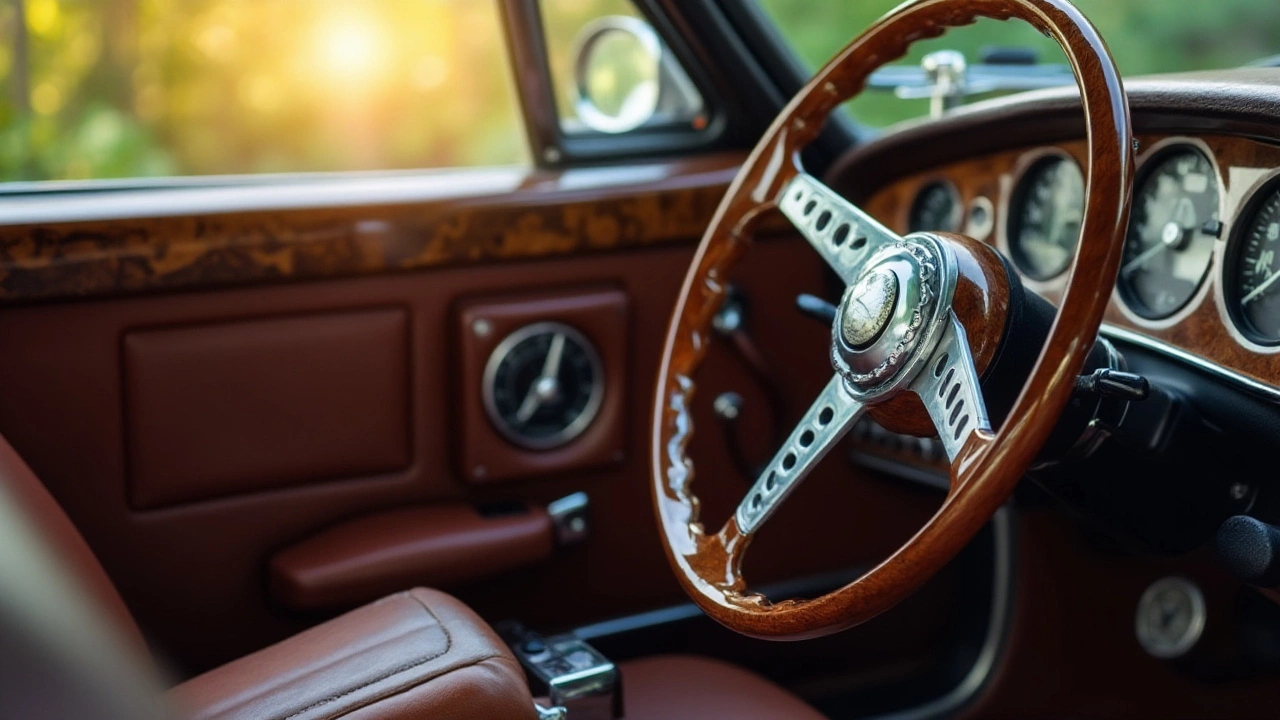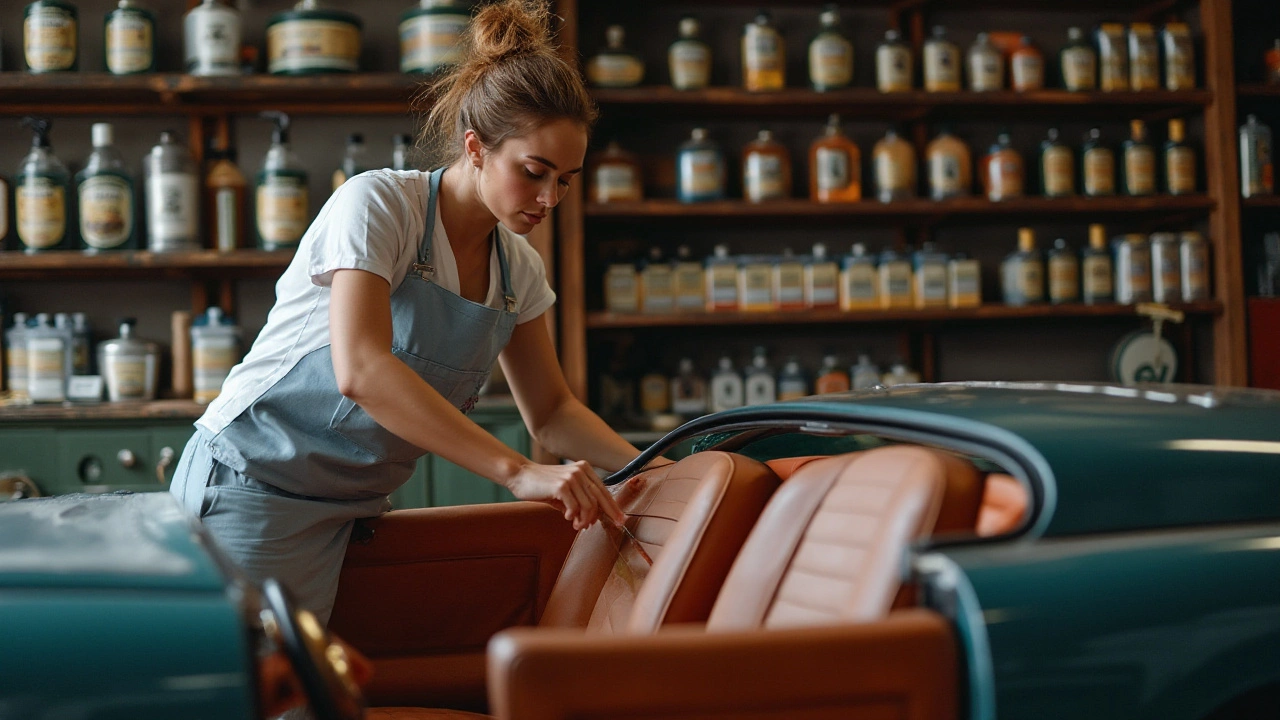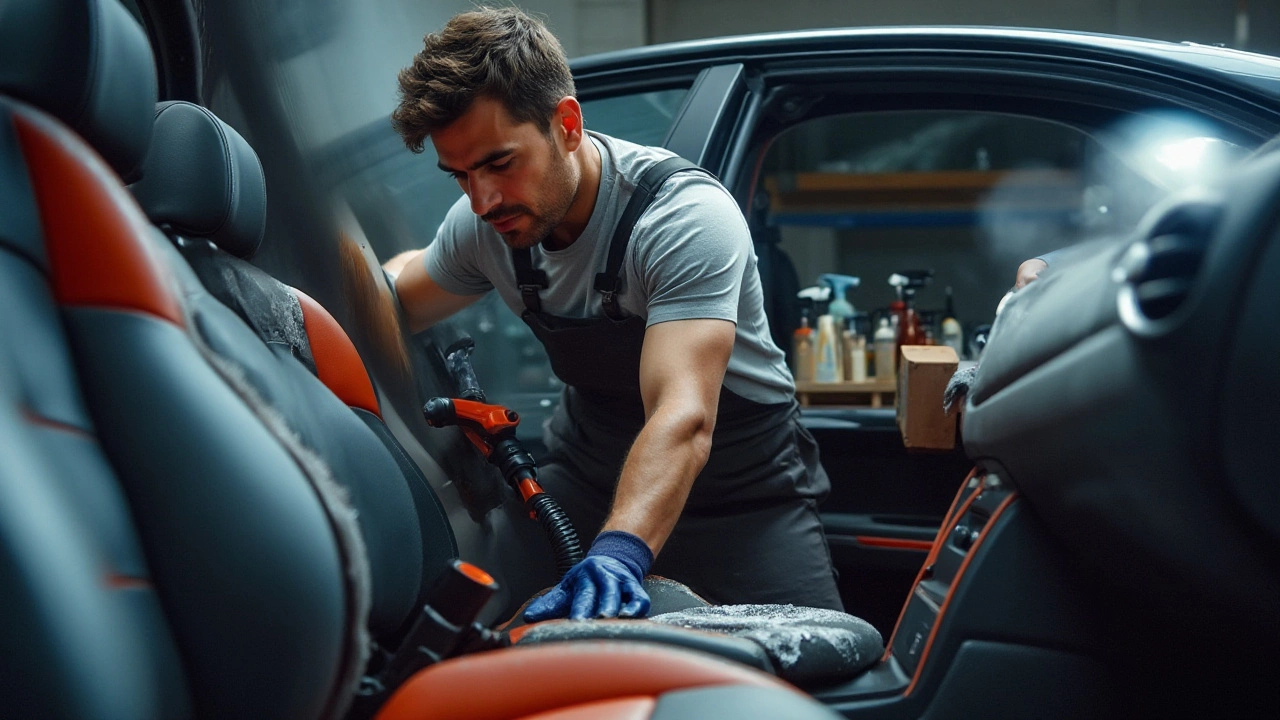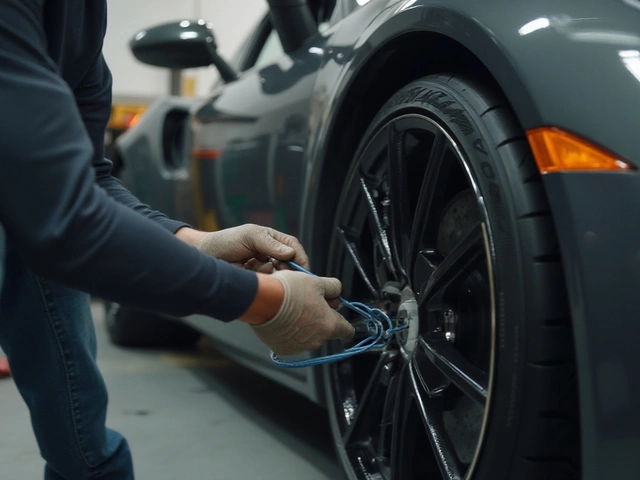When it comes to car care, the interior often tells a story about the driver. Whether you're looking to impress potential buyers or simply want to enjoy a fresher ride, mastering the art of car interior detailing can make a huge difference. A spotless cabin doesn't just happen overnight; it’s about knowing which areas need attention and how to treat them effectively.
In today’s guide, we’ll walk you through the steps to detail your car's interior like a seasoned pro. We’ll explore everything from prepping your space and gathering the right tools, to specific techniques for tackling stubborn stains and keeping surfaces gleaming. We'll also share insider tips to help maintain your car’s interior long after your detailing session. Whether you’re a hobbyist or aspiring detailer, get ready to take your car's interior from drab to fab.
- Preparing Your Workspace
- Essential Tools and Materials
- Cleaning Different Surfaces
- Detailing Techniques for Carpets and Upholstery
- Dashboard and Console Care
- Maintaining a Fresh Interior
Preparing Your Workspace
A clean and organized workspace is the cornerstone of effective car detailing. Before you even touch your toolkit, it's important to ensure that your detailing area is set up for success. Picture this: your workspace should not only look tidy, but should also have everything within arm's reach. There's no greater frustration than being in the middle of a project and realizing your microfiber cloth is buried somewhere under a pile of tools. The layout of your space can impact your efficiency and even the quality of the detailing work you perform. That's why it's crucial to think ahead and plan accordingly, ensuring you have ample room and a well-thought-out setup.
First off, let's talk about the location. Ideally, you'll want to choose a spot that's sheltered from the elements. Wind and dust can ruin a detailing session faster than a kid with a sticky ice cream cone. Some folks prefer working in garages, while others create pop-up spaces with tents or carports. The main goal here is to have a space where you can focus on the interior cleaning, without interruptions from external factors. It's worth considering the lighting in your workspace as well. Good lighting can help you spot dirt and grime that might otherwise go unnoticed. Using natural light is beneficial, but if it's not available, invest in quality LED lamps to illuminate your working area effectively.
As for tools and equipment, keep them above ground and organized in a logical fashion. Use hooks or wall-mounted racks for spray bottles, and shelves for storing bigger items. Having a portable cart can also be a game-changer, especially when you're transitioning between different parts of the vehicle. You can load it up with essential tools like vacuums, brushes, and cleaning solutions, so you're not constantly walking back and forth. Some people swear by storing tools in sequence of usage, while others prefer grouping them by type. There's no right or wrong—just what feels most intuitive and improves your workflow.
Given that you're preparing to enhance the vehicle maintenance game plan, it's worth noting that temperature plays an underrated role in detailing. During hotter months, chemical cleaners may dry too quickly, leaving residue or streaks. Conversely, colder conditions might make some products less effective. If you can control the temperature, aim for a comfortable middle ground. Listening to pro detailers gives an added dimension to this:
"The environment you work in is as much a tool as the brushes and cloths you hold. A well-prepared space sets the stage for exceptional results," shared Dave, a veteran in the detailing industry.
An often overlooked aspect is personal comfort and safety. The detailer's walk to a perfect car interior can be long; standing on hard avenues for extended hours could be tough. Therefore, it's wise to invest in anti-fatigue mats where you'll be parking your feet for the longest durations. Equally important are safety goggles and gloves when handling chemicals, ensuring your personal protection. This step isn't only about keeping your space organized—it's about organizing your approach to make interior detailing a pleasure rather than a chore.
To round it all off nicely: get into a habit of maintaining your workspace post-detailing. Cleaning up any chemical spillage, vacuuming debris, and reintegrating tools into their respective places keeps future projects smooth sailing. Declutter regularly, and you'll notice an uptick in both speed and effectiveness for your professional car care ventures. Let's face it: a happy working environment leads to a happy working detailer, and when you enjoy the process, the results speak for themselves in that sparkling dashboard reflection.
Essential Tools and Materials
Detailing the interior of a car like a professional requires more than just enthusiasm; it demands a precise selection of tools and materials tailored for various surfaces and cleaning needs. Car detailing is as much about having the right equipment as it is about technique. You wouldn't attempt to cook a gourmet meal without the proper utensils, and the same principle applies here. The right tools not only make the job easier but also ensure that you don’t inadvertently cause damage to sensitive surfaces.
To begin with, a dependable vacuum cleaner with multiple attachments is paramount. A compact but powerful vacuum can help reach those tricky nooks and crannies between seats and along the dashboard where dirt loves to hide. Look for models with attachments such as crevice tools and brush heads to handle varied surfaces like carpets and seat covers. Next on the list is a quality set of microfiber cloths. These are essential not only due to their softness, which prevents scratches, but also because of their high absorbency and ability to pick up dirt without merely pushing it around. The importance of these little cloths cannot be overstressed in effective interior cleaning.
A reliable interior cleaner safe for all surfaces is another must-have in your arsenal. Many pros prefer products that combine both cleaning and conditioning, especially for leather seats. When selecting these cleaners, ensure they're suitable for both fabric and leather to avoid having to stock multiple products. Don’t skimp on investing in gentle bristle brushes; they work wonders when dislodging dirt from upholstery fibers without tearing or fraying the fabric. For lovers of that polished look, specialty glass cleaners make wiping windows a streak-free breeze. Consider adding a concentrated fabric cleaner for carpets and mats too, which are frequently the dirtiest parts of a vehicle’s interior.
“Action expresses priorities,” said Mahatma Gandhi, and this echoes true even in car detailing—prioritizing the right equipment elevates your efficiency and outcome.
For an added layer of sophistication, maintaining interior air quality is essential, leading us to air purifying or deodorizing solutions. These can range from ozonators to simple spray-on fresheners. For those battling stubborn odors, enzyme-based solutions effectively neutralize smells by breaking down organic matter rather than masking it with synthetic fragrances. The environmental consciousness has also seeped into detailing kits, with many opting for eco-friendly solutions that are biodegradable and safe for home disposal, ensuring your car care routine doesn’t compromise the planet.

Cleaning Different Surfaces
When it comes to car detailing, not all surfaces are created equal, and each material demands a unique touch to truly shine. Seats, dashboard, windows, plastics, metals, and fabrics each present their own set of challenges. It's important to approach each one with care and the right tools. Let’s start with one of the most underestimated yet critical materials: fabrics and upholstery. These are like a sponge for grime and odors, but with the right approach, you can restore them to their former glory. Use a vacuum with a powerful suction capability to start. The suction is crucial for dislodging the tightly tucked dust and dirt, especially between the seam lines and under the seats.
Next, applying a specialized fabric cleaner can make a world of difference. Remember to do a spot test in a hidden area first to ensure it won’t discolor or damage the fabric. Gently scrub the surfaces with a soft-bristled brush or microfiber cloth, allowing the product to lift debris effectively. Have patience here; for stubborn stains, let the cleaner sit a little longer before removing. Don't underestimate the power of simple warm water and mild soap for certain stains either—sometimes, less is more.
For the dashboard and plastics, a different approach is necessary. These surfaces often accumulate dust and greasy residues, especially on touch screens. Anti-static wipes can help maintain a dust-free surface. It’s advisable to avoid using products that leave an oily residue, as they can attract more dirt quickly. And here's a tip: a soft-bristled toothbrush can work wonders in the tight spaces around buttons and knobs.
Glass surfaces like windows and mirrors can be particularly challenging due to streaks or smudges that seem to appear out of nowhere. Use dedicated car window cleaning products as these are often designed to evaporate quickly, preventing streaks. Ensure to wipe in a consistent direction—preferably vertically on the inside and horizontally on the outside—to prevent streaks.
Lastly, let's not forget the metals and chrome often found inside higher-end vehicles. These add a touch of elegance but tarnish easily with neglect. A non-abrasive metal polish can restore shine without scratching. Apply it with a microfiber cloth for best results. Often, this final touch can be what elevates the perceived cleanliness and quality of the interior to that 'like new' feel.
"Using the right product for the right surface isn’t just about achieving a clean look; it’s about prolonging the life and quality of the vehicle’s interior," says detailing expert John Koski, who has been in the industry for over a decade.
Considering these diverse surfaces and the different methods required to clean them emphasizes the importance of tailored care. By understanding the properties and needs of each material, not only do you achieve exceptional cleanliness, but you also contribute to the preservation of your vehicle's interior, maintaining its value and appeal over time.
Detailing Techniques for Carpets and Upholstery
When it comes to car interior detailing, tackling the carpets and upholstery might seem like a daunting task, but with the right approach, it can actually become an enjoyable experience. Start by thoroughly vacuuming every nook and cranny of the carpet and seats. A powerful vacuum with various attachments will help you reach those tight spots under the seats and between the vehicle's crevices. Be patient as you run the vacuum over the surfaces to ensure that no debris is left behind, as even the smallest particles can hinder the cleaning process later on.
Before diving into deep cleaning, identify the type of upholstery and carpet materials in your car. This step is crucial because different fabrics demand different cleaning agents. For example, synthetic fabrics are often more stain-resistant and easier to clean than natural ones. Read the labels on your cleaning products to ensure they're safe for your car’s interior materials. Misting the cleaner evenly can help you avoid over-saturating the fabric, which can lead to mold buildup over time.
"A good detailer knows the fabric, and listening to your car's needs can make all the difference," says renowned auto-detailing expert George Vetter.
Once the fabric type and cleaning solutions are confirmed, proceed with a spot testing. Apply your chosen cleaner to an inconspicuous area first to make sure there are no adverse reactions, such as discoloration or fading. If everything checks out, you can move on to a full cleaning. Use a soft-bristled brush to gently work the cleaner into the granules of the fabric. By agitating the fibers, you can lift dirt and stains more effectively, thus reviving the vibrancy of your seats and carpets. Allow the cleaner to sit for a few minutes to break down stains, but do not let it dry out completely before rinsing.
After cleansing, it’s essential to extract any remaining moisture from the textiles. Leaving your vehicle in a dry and airy place, preferably with good sun exposure, speeds up the drying process naturally. This is an important step to prevent unpleasant odors or mildew forming inside the cabin. If you live in a humid area, consider using a wet/dry vacuum or a carpet extractor for more efficient moisture removal. This technique not only enhances the cleanliness but also rejuvenates the entire feel of your vehicle's interior.
To maintain a pristine condition, consider applying a fabric protector. These products form an invisible shield, making future spills easier to clean by preventing them from penetrating the fabric instantly. Regular brushing and scheduled deep cleaning ensure that the carpets and upholstery retain their texture and color, giving lasting impressions. Remember, constant vigilance is key. Keeping an eye on small spills and addressing them promptly will preserve your vehicle’s interior appeal.
When meticulously applied, these techniques reflect the kind of care that resonates with both the car and you, the driver. From diligent vacuuming and savvy spotting, to using the right cleaners and protectants, each step plays a vital role in maintaining that crisp, clean vibe that makes stepping into your car a delight every single time.

Dashboard and Console Care
The dashboard and console are more than just the cockpit of your vehicle; they are the visual focal points that greet you every time you step inside. Taking care of these parts of your car not only enhances your driving experience but can also protect your investment. Dust, grime, and UV rays are the notorious culprits that can cause dashboard and console deterioration, cracking or fading over time. It's essential to clean and protect these surfaces regularly to maintain that crisp, new-car feel. The right techniques and products can make a world of difference. Start by using a soft microfiber cloth to gently remove dust and dirt. You don't want to use harsh-textured materials that might scratch the surface. Pay particular attention to every nook and cranny, as dust loves to settle in those hidden corners.
When it comes to cleaning solutions, the choice can be overwhelming, but don't let this deter you. Look for a product specifically designed for automotive interiors to ensure optimal results. Avoid anything containing alcohol or ammonia, as these can lead to discoloration over time. One simple home remedy involves a mixture of mild soap and water. Just be sure to wring out the cloth thoroughly to avoid excess moisture. Console buttons and screens require special attention. Use a cotton swab or a soft brush to reach those tight spots and gently clean the grit and grime that accumulates around these areas. A thoughtful approach can keep your console's electronics safe and looking sharp.
According to the International Carwash Association, "Regular cleaning and maintenance can extend the life of your vehicle interior by up to 50%." This underscores the importance of making dashboard care a routine task rather than an occasional chore.
Protective measures are just as crucial as cleaning. After cleaning, apply a quality dashboard protectant that includes UV protection. This will help to block harmful sun rays that cause aging and fading. Products with a semi-gloss finish are ideal as they reduce glare, enhancing safety while driving. Always follow the instructions on the product label for the best results. Remember to wipe away any excess product to avoid a slick or oily finish which can attract more dust. Regular attention to these strategies ensures your dashboard remains as good-looking as it is functional, preserving both the vehicle’s aesthetic and resale value.
A little-known factor that affects dashboard longevity is the climate you live in. In hot, sunny climates like sunny Brisbane, the sun's intensity can be quite unforgiving. Here, using a sunshade when the vehicle is parked can provide significant added protection. Keeping windows slightly open when parked minimizes heat build-up inside the car. By following these simple steps and making care for your dashboard and console a habitual practice, you not only maintain the appearance of the interior but also lower the costs associated with potential repairs or replacements in the future.
Maintaining a Fresh Interior
Keeping your car's interior fresh is not only about the clean appearance but also about ensuring that delightful aroma when you first open the door. Regular maintenance is key to extending the life of those detailing efforts. A significant part of maintaining a fresh interior lies in habits. Establishing a monthly routine for quick touch-ups can prevent dirt buildup and keep the environment more pleasant. Start by regularly vacuuming loose debris and dirt using a reliable vacuum with a HEPA filter, particularly if allergies are a concern. This filtration helps capture allergens and promotes better air quality inside your vehicle.
Equally important are the use of quality products designed for automotive interiors, which provides a protective barrier against future spills and sun damage. For leather surfaces, a monthly application of a conditioner would prevent cracking and maintain suppleness. Cloth seats, on the other hand, benefit from a spray fabric protector, making stains less likely to settle. For those tackling this task themselves, Jeffrey Blackwell from the Australian Automotive Association shares a valuable insight,
"Consistency in care elevates the lifespan and comfort of any car's interior, turning simple maintenance into a rewarding routine."
Regular Air Freshening
Adding an air-freshening strategy is essential. Many individuals overlook cabin air filters which should be replaced every 15,000 to 25,000 kilometers, as they affect both smell and quality of air inside the car. Choose natural, non-toxic air fresheners to avoid overwhelming scents that can sometimes mask bad odors instead of eliminating them. Open the windows occasionally to allow fresh air circulation, especially after cleaning sessions. A discreetly placed sachet of charcoal or baking soda under the seats can absorb unwanted odors naturally over time.
Long-Term Care and Strategies
For those who frequently transport pets or children, the challenge of maintaining a fresh interior can feel daunting. Protective seat covers or a pet hammock for the back seat add a layer of defense, making clean-up after a trip to the dog park significantly easier. Develop a habit of wiping down door handles, steering wheels, and consoles with a microfiber cloth soaked in mild detergent once a week. These high-touch areas are havens for germs and need regular attention to keep them sanitary.
While much of the advice here emphasizes preventive care, it cannot be overstated how beneficial it is to let professionals handle the deeper, complex detailing at least once a year. Statistics suggest that professional detailing not only improves resale value by up to 15% but also significantly enhances the driving experience by maintaining a pleasant environment. Adopting these strategies will help ensure that your vehicle remains a comfortable and inviting space for as long as you own it.






